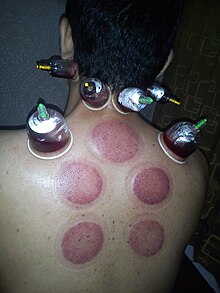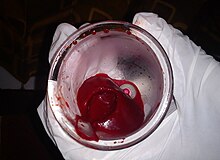This is an old revision of this page, as edited by Saedon (talk | contribs) at 20:33, 16 June 2012 (Reverted 2 edits by HacksBack (talk): Edit warring does not work on WP. See WP:CONSENSUS. You have been reverted by two editors now. (TW)). The present address (URL) is a permanent link to this revision, which may differ significantly from the current revision.
Revision as of 20:33, 16 June 2012 by Saedon (talk | contribs) (Reverted 2 edits by HacksBack (talk): Edit warring does not work on WP. See WP:CONSENSUS. You have been reverted by two editors now. (TW))(diff) ← Previous revision | Latest revision (diff) | Newer revision → (diff)
Hijama (Template:Lang-ar lit. "sucking") is the name in Arab traditional medicine for wet cupping, where blood is drawn by vacuum from a small skin incision for therapeutic purposes. Hijama is generally performed by Muslims as it is a form of medicine specifically mentioned and encouraged by the Islamic prophet Muhammad. Among other hadith, it is mentioned in that recorded by Muhammad al-Bukhari (5263) and Muslim ibn al-Hajjaj (2952), saying "The Hijama is the best of your remedies" (خير ما تداويتم به الحجامة).
Procedure

Hijama can be performed anywhere on the body, often at the site of an ache or pain in order to ease or alleviate it. A more conservative approach warns against over use of cupping and suggests only that six optimal points on the body are all that is required to "clean" the entire cardiovascular system: The back of the head, two shoulders corresponding to the acupuncture heart position, the tail or small of the back, and the two inner ankles.
The location is first shaved, if necessary, to ensure a tight seal with the cup. The mouth of a cup (metal, glass and plastic cups are generally used, although traditionally horns were used) is placed on the skin at the site chosen for cupping. Then a tight seal is created. The traditional method was to burn a small piece of paper or cotton inside the vessel, so that the mouth of the cup clings to the skin. Some practitioners now use a machine instead, although others strictly adhere to the Prophetic method with the use of fire, both for sterility and the benefits or properties from the element of fire itself. The cup is left to cling to the skin for a few minutes, then it is lifted off and a couple of very small incisions are made in the skin. The cup is then put back as it was before until the flow of blood subsides.
Hijama is considered a form of energy medicine because it has been claimed to unclog the meridians in the body, and is viewed by some practitioners as a cure that can alleviate black magic and possession.
See also
- Bloodletting
- Ijaza
- Fire cupping
- Medicine in medieval Islam
- Blood donation
- Hematology
- History of medicine
References
- Traditional Medicine Among Gulf Arabs Part II - Blood Letting, Albinali, H. A. Hâyar, Heart Views, Volume 5, No.2, June–August 2004
- Cupping, Hijama, Buhwang . . .
- Traditional Cupping Hijama Educational Course
- Observations of the popularity and religious significance of blood-cupping (al-ḥijāma) as an Islamic medicine, Ahmed El-Wakil, Contemporary Islamic Studies, Vol. 2011, 2